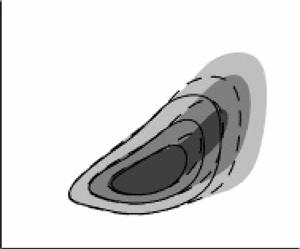No CrossRef data available.
Article contents
A data-driven quasi-linear approximation for turbulent channel flow
Published online by Cambridge University Press: 31 January 2024
Abstract

A data-driven implementation of a quasi-linear approximation is presented, extending a minimal quasi-linear approximation (MQLA) (Hwang & Ekchardt, J. Fluid Mech., vol. 894, 2020, p. A23) to incorporate non-zero streamwise Fourier modes. A data-based approach is proposed, matching the two-dimensional wavenumber spectra for a fixed spanwise wavenumber between a direct numerical simulation (DNS) (Lee & Moser, J. Fluid Mech., vol. 774, 2015, pp. 395–415) and that generated by the eddy viscosity enhanced linearised Navier–Stokes equations at  $Re_\tau \approx 5200$, where
$Re_\tau \approx 5200$, where  $Re_\tau$ is the friction Reynolds number. Leveraging the self-similar nature of the energy-containing part in the DNS velocity spectra, a universal self-similar streamwise wavenumber weight is determined for the linearised fluctuation equations at
$Re_\tau$ is the friction Reynolds number. Leveraging the self-similar nature of the energy-containing part in the DNS velocity spectra, a universal self-similar streamwise wavenumber weight is determined for the linearised fluctuation equations at  $Re_\tau \simeq ~5200$. The data-driven quasi-linear approximation (DQLA) provides noteworthy enhancements in the wall-normal and spanwise turbulence intensity profiles. It exhibits a qualitatively similar structure in the spanwise wavenumber velocity spectra compared with the MQLA. Additionally, the DQLA offers extra statistical outputs in the streamwise wavenumber coordinates, enabling a comprehensive global analysis of this modelling approach. By comparing the DQLA results with DNS results, the limitations of the presented framework are discussed, mainly pertaining to the lack of the streak instability (or transient growth) mechanism and energy cascade from the linearised model. The DQLA is subsequently employed over a range of Reynolds numbers up to
$Re_\tau \simeq ~5200$. The data-driven quasi-linear approximation (DQLA) provides noteworthy enhancements in the wall-normal and spanwise turbulence intensity profiles. It exhibits a qualitatively similar structure in the spanwise wavenumber velocity spectra compared with the MQLA. Additionally, the DQLA offers extra statistical outputs in the streamwise wavenumber coordinates, enabling a comprehensive global analysis of this modelling approach. By comparing the DQLA results with DNS results, the limitations of the presented framework are discussed, mainly pertaining to the lack of the streak instability (or transient growth) mechanism and energy cascade from the linearised model. The DQLA is subsequently employed over a range of Reynolds numbers up to  $Re_\tau = 10^5$. Overall, the turbulence statistics and spectra produced by the DQLA scale consistently with the available DNS and experimental data, with the Townsend–Perry constants displaying a mild Reynolds dependence (Hwang, Hutchins & Marusic, J. Fluid Mech., vol. 933, 2022, p. A8). The scaling behaviour of the turbulence intensity profiles deviates away from the classic
$Re_\tau = 10^5$. Overall, the turbulence statistics and spectra produced by the DQLA scale consistently with the available DNS and experimental data, with the Townsend–Perry constants displaying a mild Reynolds dependence (Hwang, Hutchins & Marusic, J. Fluid Mech., vol. 933, 2022, p. A8). The scaling behaviour of the turbulence intensity profiles deviates away from the classic  $\ln (Re_\tau )$ scaling, following the inverse centreline velocity scaling for the higher Reynolds numbers.
$\ln (Re_\tau )$ scaling, following the inverse centreline velocity scaling for the higher Reynolds numbers.
- Type
- JFM Papers
- Information
- Copyright
- © The Author(s), 2024. Published by Cambridge University Press





